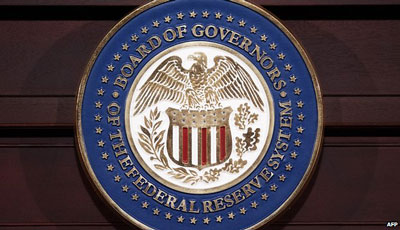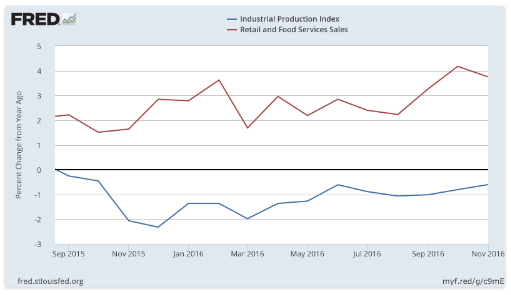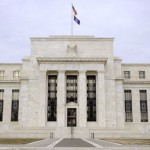The Fed Lifts Interest Rates On Outlook For Firmer Growth

 The Federal Reserve announced an increase in interest rates yesterday, nudging its target rate up by 25 basis points to a 0.50%-to-0.75% range. The central bank’s revised economic projections were slightly more hawkish too. Meantime, the government yesterday reported weaker-than-expected numbers for retail sales and industrial production in November, fueling debate about the wisdom of tightening monetary policy.
The Federal Reserve announced an increase in interest rates yesterday, nudging its target rate up by 25 basis points to a 0.50%-to-0.75% range. The central bank’s revised economic projections were slightly more hawkish too. Meantime, the government yesterday reported weaker-than-expected numbers for retail sales and industrial production in November, fueling debate about the wisdom of tightening monetary policy.
Retail spending rose 0.1% last month, well below the consensus forecast for a 0.4% gain. Meanwhile, industrial production fell 0.4% in November, double the expected decline, according to Econoday.com’s survey data.
Although the monthly comparisons weakened, the year-over-year data offered a modestly brighter profile. Retail spending increased 3.8% in November vs. the year-earlier level. Although that’s down from the 4.2% advance in the previous report, spending continued to rise at a rate that’s close to the fastest annual pace in nearly two years.
Industrial production, however, continued to suffer red ink for the year-over-year change, dipping 0.6% last month vs. the year-ago level. Note, however, that the annual decline continued to ease, leaving room for arguing that the industrial sector’s still on track for a modest recovery in 2017.

Fed Chair Janet Yellen opted to put a positive spin on the big-picture review in yesterday’s press conference, explaining that the latest increase in rates follows “the considerable progress the economy has made toward our dual objectives of maximum employment and price stability.”
The Fed also tweaked its economic projections yesterday, raising its outlook for growth ever so slightly. For instance, GDP for this year is now projected to increase 1.9% (a touch higher than the 1.8% estimate in the September forecast) and growth in 2017 will tick up to 2.1% (vs. 2.0% in the previous outlook). In addition, the Fed is now anticipating that it will raise interest rates three times next year, lifting the target rate by an additional 0.75 percentage point overall—a faster pace than anticipated in the central bank’s September projection.
The rationale, according to Yellen in a prepared statement: “GDP growth is a touch stronger, the unemployment rate is a shade lower, and inflation, beyond this year, is unchanged.”
Nonetheless, the near-term view still assumes that growth will be modest at best, an assumption that wasn’t lost on critics of yesterday’s policy decision. Highlighting the potential risk to the Fed’s plans, the Atlanta Fed’s nowcast for fourth-quarter growth was revised down yesterday to 2.4%, moderately below the 3.2% pace in Q3.
Some analysts have cut Q4 growth estimates even further. JP Morgan, for instance, sliced its estimate yesterday to 1.5% from 2.0%, in part because the bank now expects that consumer spending will expand at a slower in Q4 than previously estimated.
The chief executive of the country’s largest manufacturer, General Electric, however, is on board with the view that the US economy will continue to make progress in the new year. Speaking to investors in New York, Jeff Immelt said that before election the economy “was already grinding upwards. You just hear a lot more optimism: people thinking about projects that we weren’t thinking about before.” He added that “it’s great to get the economy back to a point where it’s growing fast enough that people think [higher] interest rates are a good thing. So I’m happy to see it and even more on the way.”
Harvard economist Ken Rogoff thinks that the incoming Trump administration will juice growth, thanks to a policy prescription of cutting taxes, reducing regulation, and rolling out new infrastructure-building projects.
“Yes, it still could all end very badly. The world is a risky place. If global growth collapses, US growth could suffer severely,” Rogoff wrote earlier this week. “Still, it is far more likely that after years of slow recovery, the US economy might at last be ready to move significantly faster, at least for a while.”
For the moment, the Fed doesn’t disagree.
By James Picerno, http://www.capitalspectator.com/
Find more: Contributing Authors




























